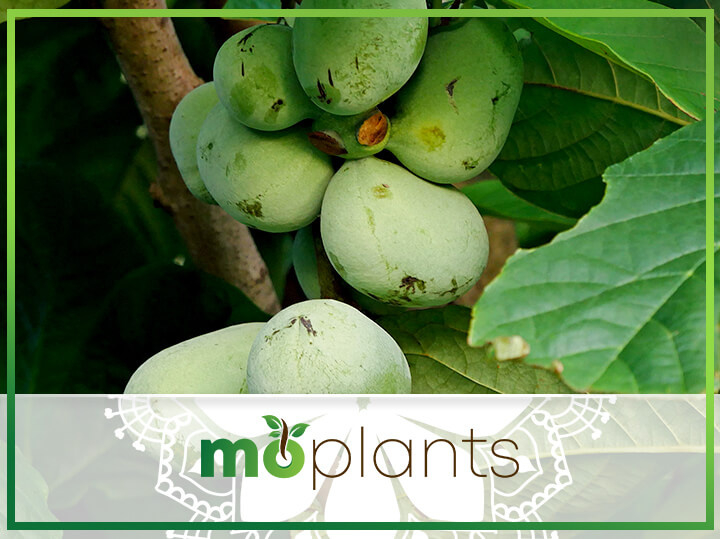It’s a surprise if you’ve never heard of the pawpaw fruit before. You won’t see pawpaws in grocery stores because they’re hard to keep and transport.
However, the pawpaw is making a comeback for foodies, health nuts, and Earth lovers alike.
Read on to find out about pawpaws and see how you can get your hands on this great, truly American, power fruit.
What Is a Pawpaw Fruit?
Pawpaws, or Asimina triloba, is the largest native fruit in America. The pawpaw is a temperate fruit that grows along North America.
A pawpaw looks like the child of a mango and a banana. You could even mistake it for a papaya because of its size.
In fact, the pawpaw may have gotten its name from the Spanish word for papaya because of its size and color.
It’s easier to tell the difference between pawpaws and other fruits by opening one up. Inside, you’ll find fruit flesh with a soft custard-like texture and long, almond-shaped seeds.
What Does Pawpaw Taste Like?
Most people will tell you that pawpaws taste like a mix of mangoes and bananas, but it’s much more complex than that.
The Texture
The pawpaw fruit is part of the custard apple family, so it tastes like cherimoya from Peru or a soursop (guanábana) from Mexico. Those might be familiar tastes to you.
But if you’ve never had those tropical fruits yet, imagine this: it greets your tongue with a custardy-smooth texture, creamy and delightful.
In some varieties, the texture is reminiscent of avocadoes or an overripe banana. In others, the flesh is a bit firmer, a cross between a mango and a banana.

The Taste
One lick of the flesh and you’re hit with a delightful mixture one can only describe as tropical.
Pawpaws taste like a medley of mango sweetness and banana richness, with a zing of citrus, culminating in a subtle, bitter aftertaste.
But it’s a good bitter, like the kind in aged wine or a good beer, and more subtle, almost floral-like.
It’s hard to describe the journey your taste buds will take with a ripe pawpaw. We recommend you try it yourself.
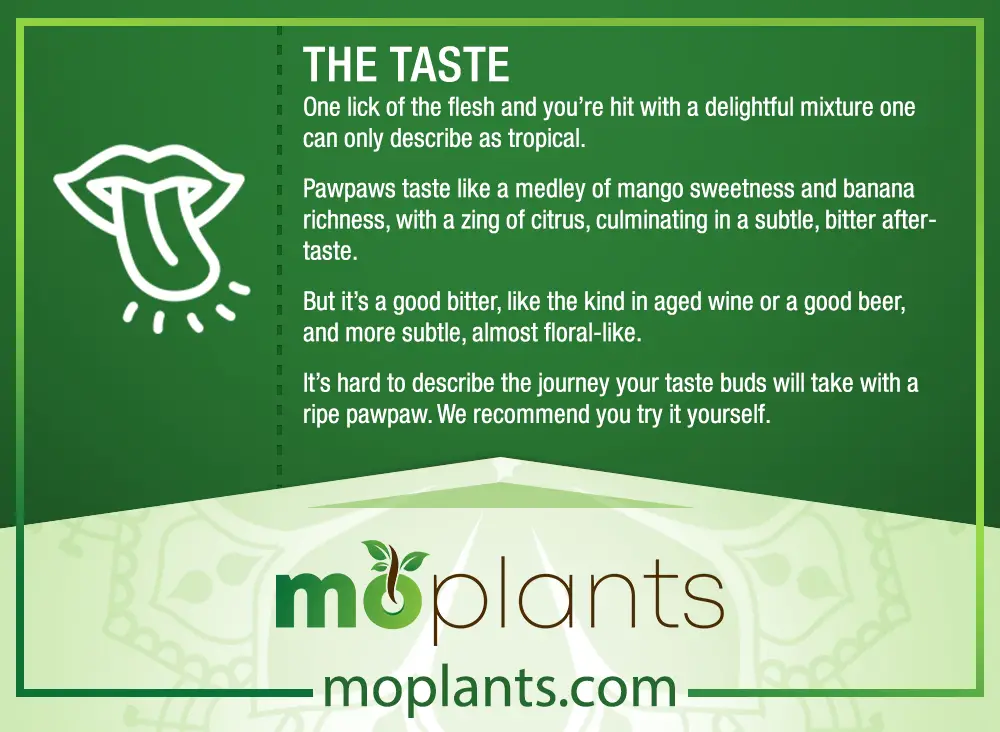
Infographic
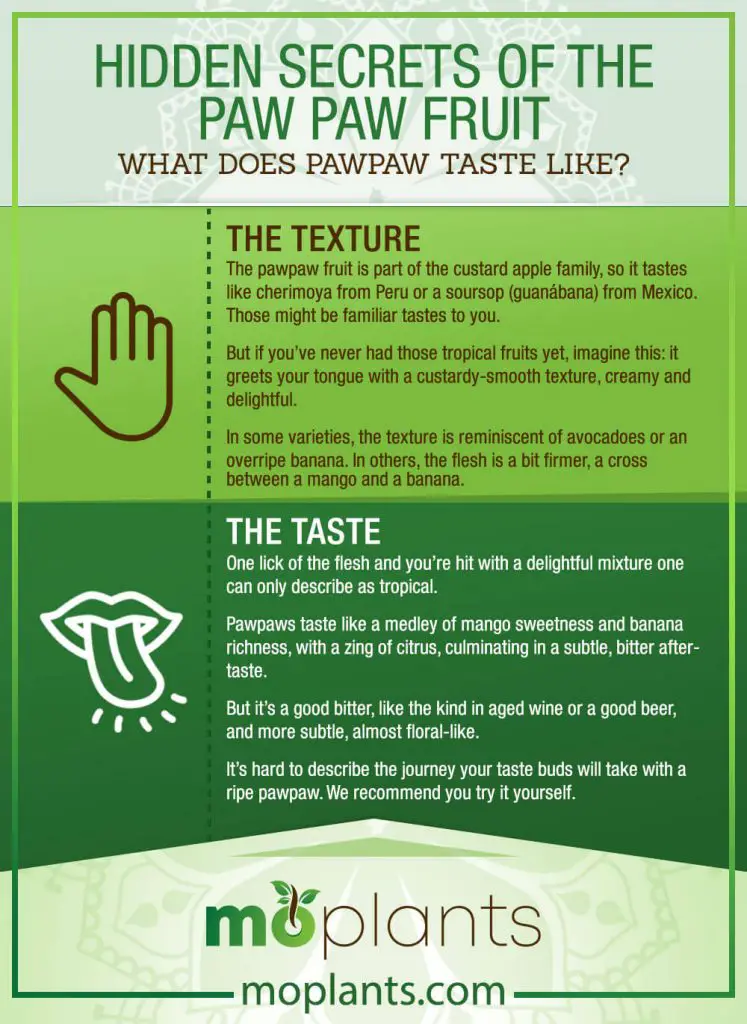
Where Did Pawpaw Trees Come From?
Closer Than You Think.
Europeans introduced plenty of fruits to America. Like apples and cherries, some of these fruits are so common that we think they’ve always been here. But here’s a fun fact for you: the Europeans imported these fruits when they sailed to America.
Here’s another fun fact: the unfamiliar pawpaw is native to North America. It grows best in the temperate climates of Eastern and Midwestern United States.
They’re most commonly found in Eastern America, from the Great Lakes region to New York, then to the Midwest, and going south until Florida. If you’re in Canada, you can find pawpaws in Ontario.
An Estranged Family
It’s a mystery how this member of the custard apple family found its way so far up North. Some scholars say that the pawpaw emerged in eastern America when the planet was much warmer and adapted to colder climates ever since.
The pawpaw fruit has a pretty long history. Native Americans regularly ate this fruit, and early settlers gave pawpaws a shot and loved it.
Even the Founding Fathers enjoyed pawpaw fruits. George Washington had pawpaws for dessert. Thomas Jefferson planted them in Monticello. How’s that for history?
How America Forgot The Pawpaw
Even if the pawpaw is a native fruit, it’s not very popular. The difficulty of transporting pawpaws and its short shelf life explains why pawpaws are hard to take off commercially.
The pawpaw tree is actually quite easy to cultivate, but the fruit has a pretty short shelf life. At room temperature, pawpaw fruit only lasts 2 to 3 days, or about 3 weeks when refrigerated.
So this explains why the pawpaw didn’t gain the massive popularity that it should. Researchers at Kentucky State University are soon trying to change that.
Making The Pawpaw Great Again
Available In Grocery Chains? Soon Enough.
Researchers from Kentucky State University are trying to make pawpaws commercially available. Their goal is to find the best pawpaw cultivars and identify the best management techniques.
The Kentucky State University program listed criteria for the fresh fruit, like flesh color, fruit size, seed size, fruit shape, and flesh taste. If a pawpaw variety does well, then the KSU will include them in its breeding program.
While the program has shown promise so far, it’s hard to tell when you could get the prized pawpaw in the big-chain grocery store.
It’s still not commercially grown because while researchers are breeding for consistency, it’s still hard to control its shelf life.
In short, the pawpaw is a supply chain nightmare. So where can you find pawpaw fruits?
Where to Find Pawpaw Fruits
In Farmer’s Markets
Because of the pawpaw’s sensitivities and shelf life, your best bet is to get them locally through farmer’s markets.
The bigger question is when to get your hands on the pawpaw. Because pawpaws are so sensitive, it takes only two to three days from picking before it turns to mush.
If you’re lucky, your farmer’s market or local grocery stores could have pawpaws available for two to three weeks. It depends on how many pawpaws your local farmers grew and harvested.
The pawpaw harvest season is usually at around September, right at the beginning of fall.
Your local newspaper might make announcements about pawpaw season. Some places even have annual events, like the Ohio Pawpaw Festival, so we suggest you watch out for those.
Foraging For Pawpaw
If you grow near a mountainous area in the Midwest where pawpaws are abundant, you’re in luck! You could forage for wild pawpaws when fall hits.
If you forage for pawpaw fruits, we suggest you check out forests with a lighter shade, as that’s the ideal environment for pawpaw trees to grow.
Grow Your Own Pawpaw
If you want a steady supply of pawpaw, we suggest you try to grow and cultivate your own. You might learn a thing or two along the way.
From Seeds
While you can try growing and germinating your own trees from pawpaw seeds, we don’t recommend this method. It takes too long for the seeds to germinate and could be erratic.
However, if you want to give it a shot, the Iowa State University suggests you could try placing the seeds in a cool, moist environment of sand and peat moss for 80-100 days. Afterward, you could plant the seeds in a pot.

From Saplings
Instead, we suggest you choose saplings from your local nursery. This way, you could choose how to propagate these trees. There are four cultivars of pawpaw available in the United States.
For best results, we recommend getting two different varieties of pawpaw. Pawpaw trees are self-incompatible. This means that cross-pollination from another unrelated pawpaw tree will give you better results.
Remember the KSU pawpaw breeding program? KSU came up with some varieties to suit your needs.
If you want a tree with heavy crops, then you might want to get the KSU-Atwood variety. If you want an early ripening variety, then the KSU-Benson might be for you.
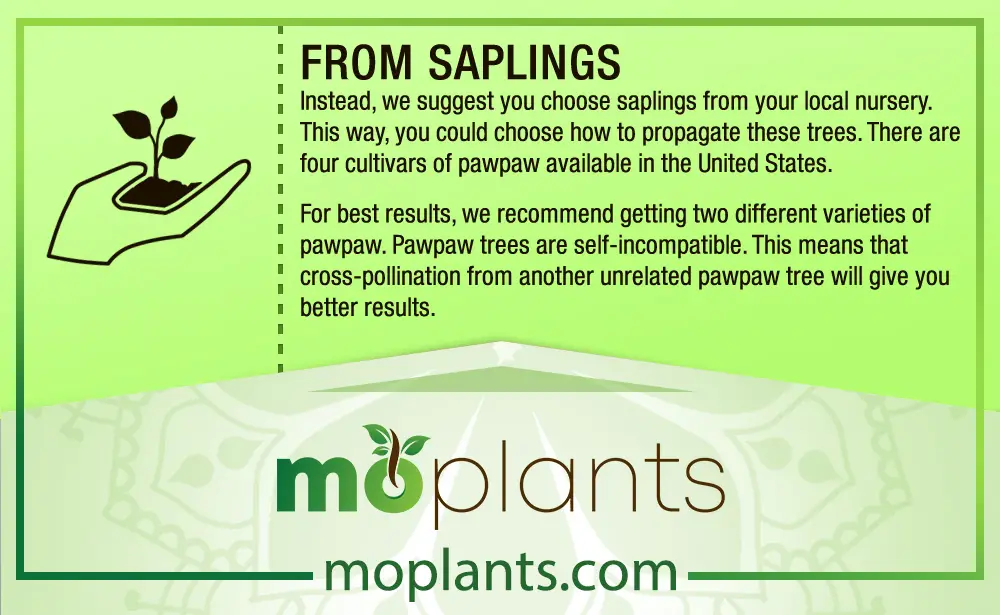
Infographic
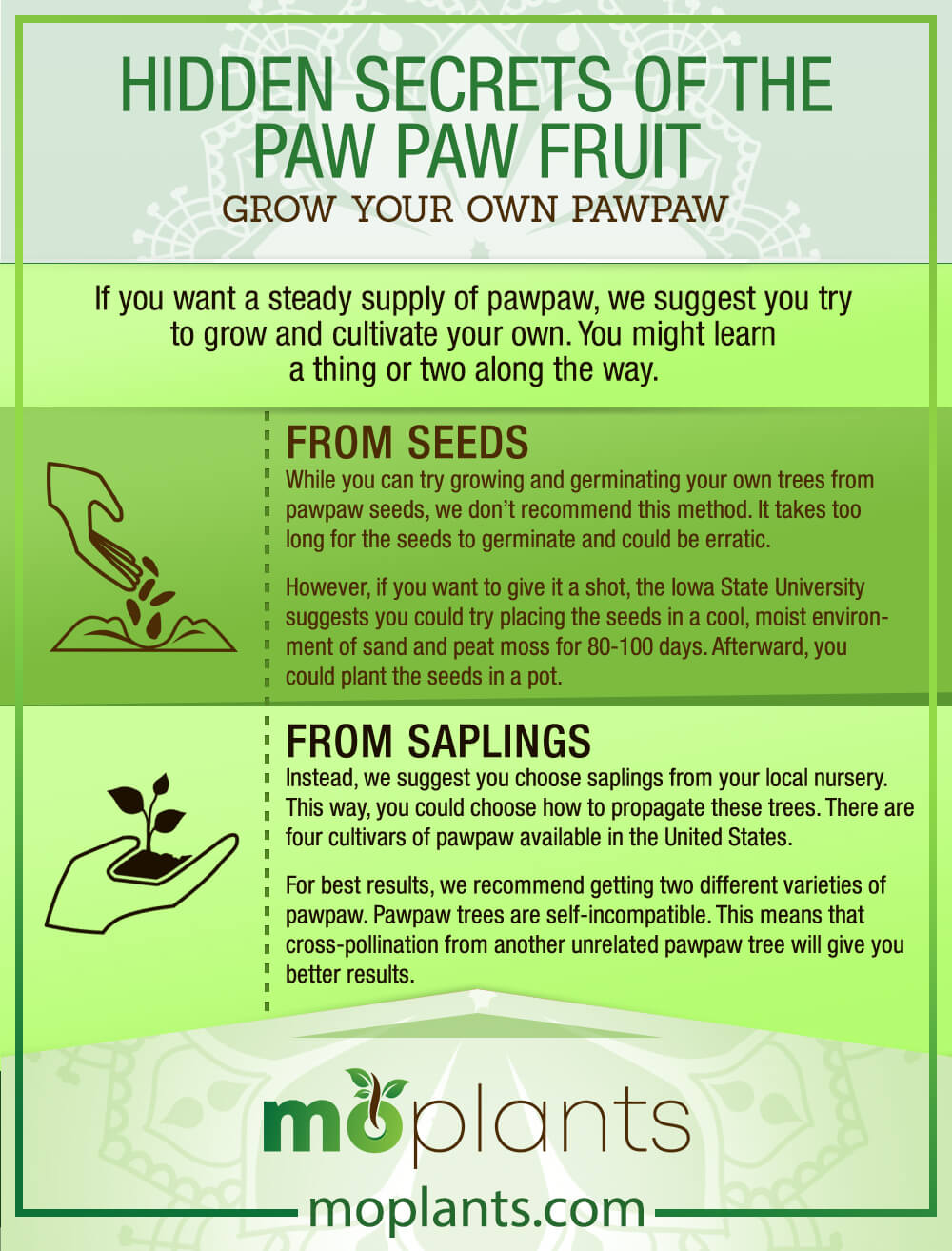
How Do You Eat Pawpaw Fruit
Now that you’ve figured out how to get your hands on a pawpaw, you might wonder: what’s the best way to eat them?
There are lots of ways to eat pawpaw, and because the pawpaw is getting really popular among foodies, there are more ways to enjoy them than ever before.
Eaten Raw
The pawpaw fruit is usually eaten raw. Just open one up and scoop the delicious flesh out. Watch out for the seeds and the skins! They’re not edible, and they don’t taste as delicious.
If you want a fruit dessert that tastes a lot like ice cream, just chill your pawpaw before serving. This was how George Washington liked to eat pawpaw.
It really is best to let the pawpaw ripen on a tree, but if you picked your fruits early, make sure you wait until it ripens under room temperature first. Otherwise, just toss pawpaw in the fridge, and you’ll be good to go.
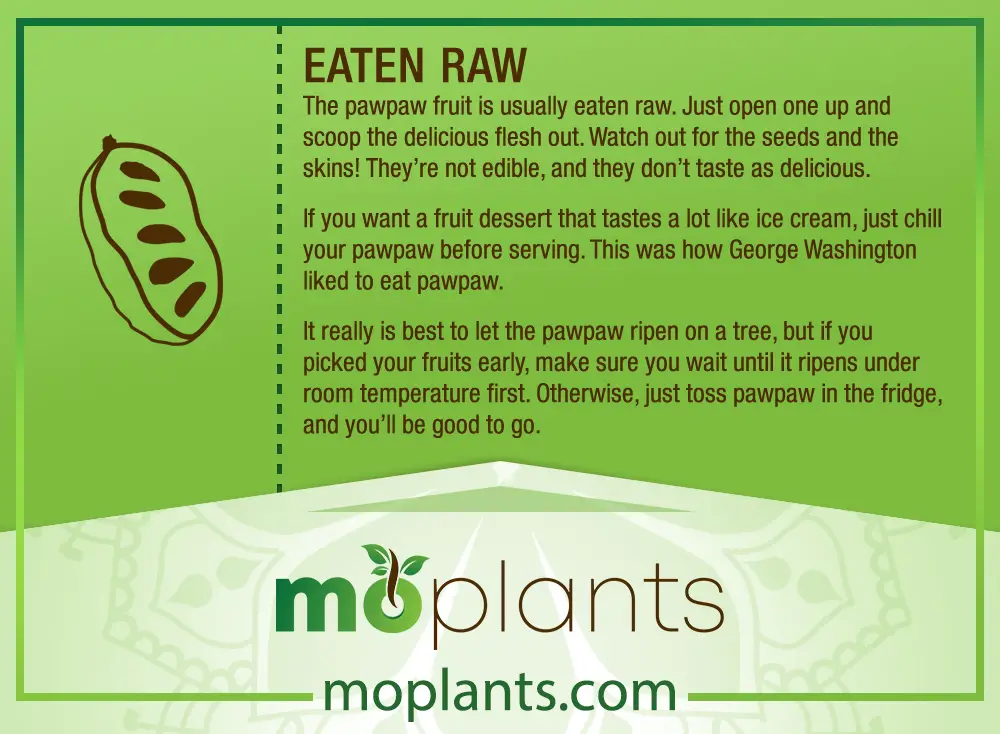
Cooking With Pawpaw
Pawpaw has a custard-like texture, so it’s hard to use the flesh as a garnish. It also oxidizes quickly, like a banana does, so it’s best that you use pureed pawpaw flesh the same day you’ve extracted them.
The easiest way to use pawpaw pulp is as a syrup in frozen desserts like frozen yogurt or in pudding recipes.
If you have a banana smoothie, banana ice cream, or banana pudding recipes lying around, you’re in luck: pawpaw behaves a lot like banana as a puree.
Besides frozen desserts, you could also try using pawpaw in your bread and cake recipes. Pawpaw fruit lends itself well to the slow heat of baking and ingredients like dairy and flour.
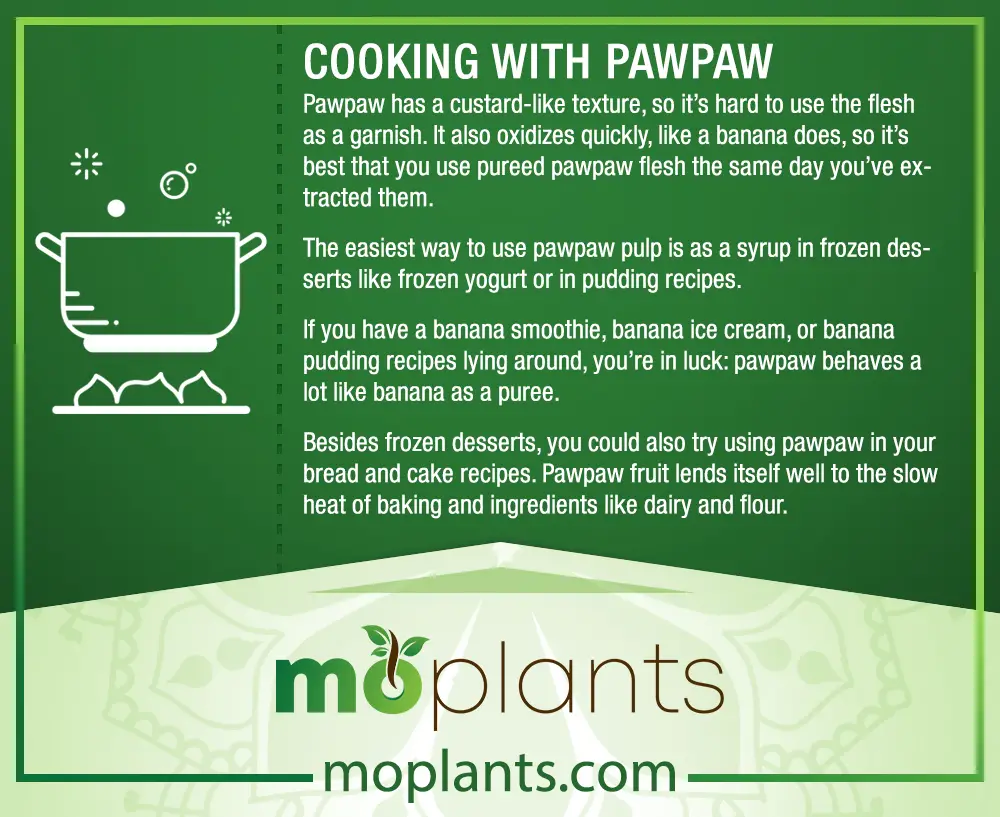
Infographic
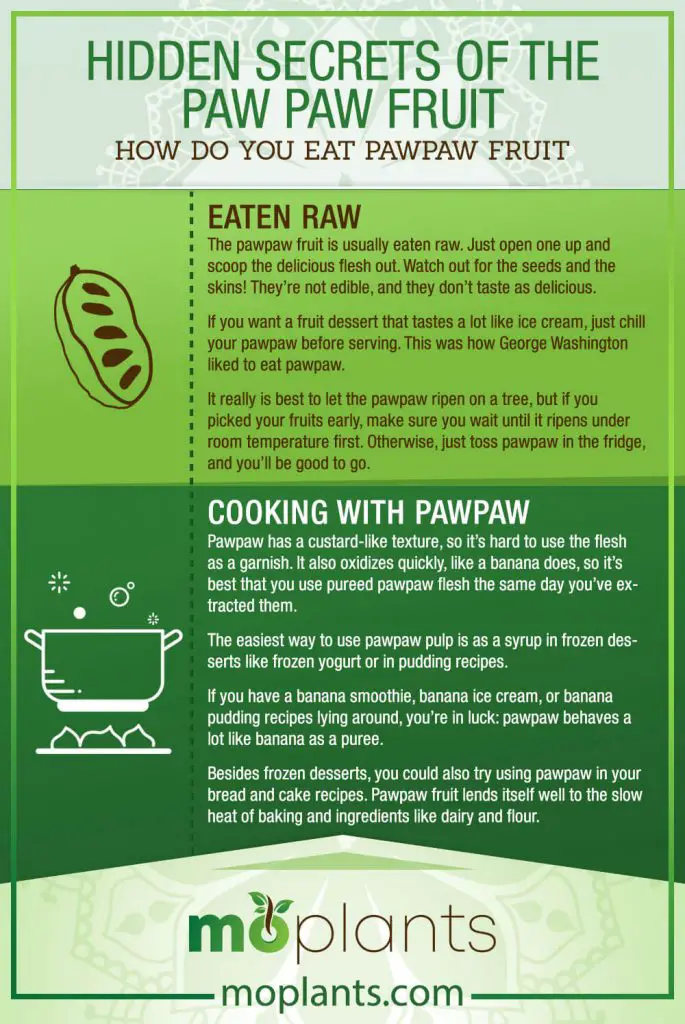
Conclusion
The pawpaw fruit is a North American wonder fruit still hidden in mystery. It’s making a comeback, though, so don’t miss out! Get your hands on this sweet delight.

